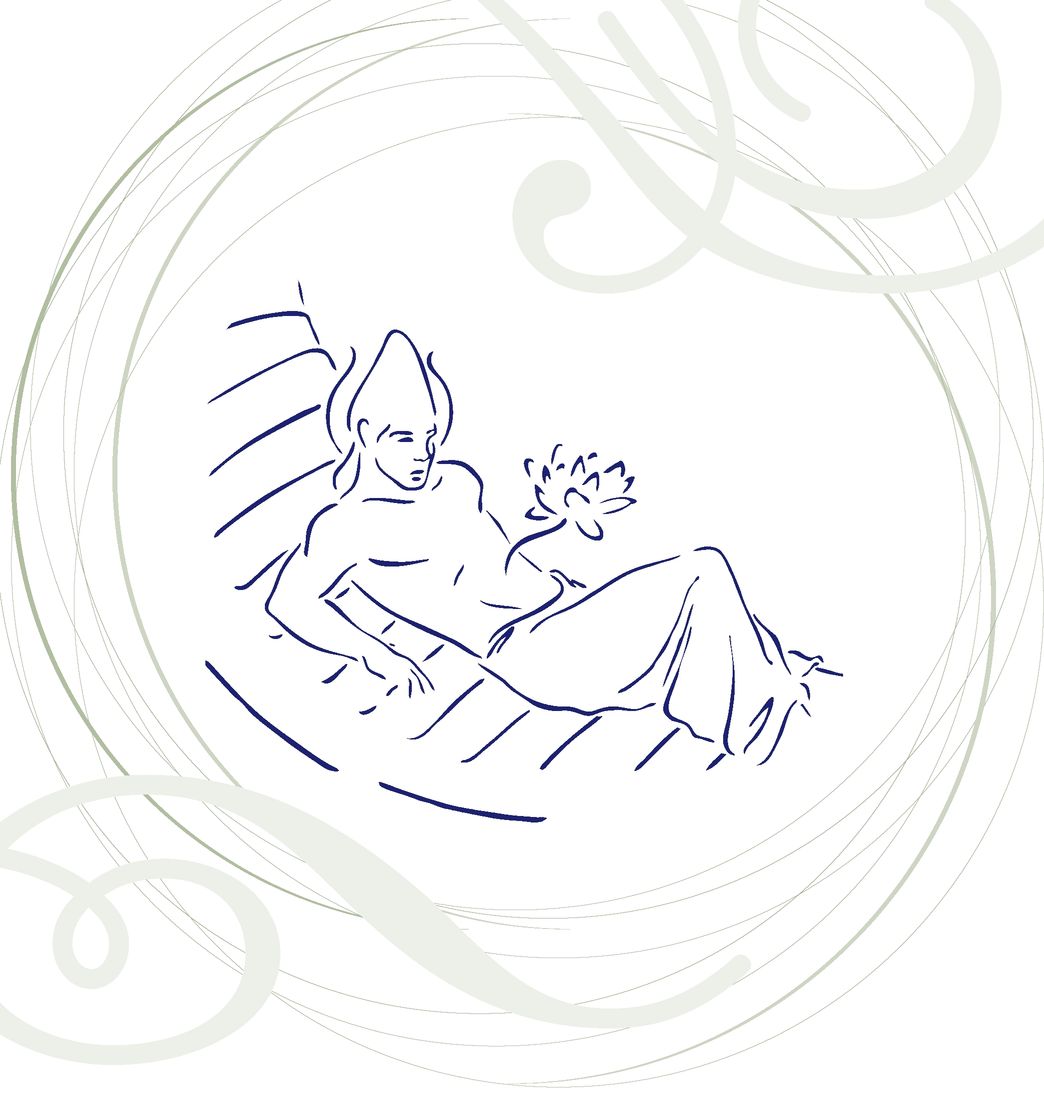padmasana
LOTUS POSE
The lotus posture is the quintessential seated meditation posture, which often eludes yogis whose hips have not yet softened through their asana practice. With the feet crossed on top of the thighs, this posture pins the thighbones to the floor, creating a grounded seat and an effortlessly straight spine. The lotus is a potent symbol for the yogi and is often associated with the creative forces within us. Another powerful symbol of creativity is the sound of OM.
Cosmic Soup
Before the dawn of time, Vishnu was resting comfortably on his couch—the thousand-headed serpent Ananta. Coiled underneath Vishnu, Ananta provided a suitable lounging place, while his numerous heads provided shelter and shade for the reclining deity. Vishnu and Ananta floated together on the cosmic sea of possibility, where all the universes enter after the cosmic annihilation. When the moment came for the creation cycle to start again, a grand lotus flower began to sprout from Vishnu’s navel.
The plant grew up right in front of him, and then the beautiful lotus flower opened to reveal the four faces of Brahma, the god of creation, nestled inside. Each of the faces was looking in one of the cardinal directions—north, south, east, and west. From each of his four mouths, Brahma uttered one of the four parts of the sacred sound of OM: “ah,” “ooo,” “mmm,” and silence. The sound caused the cosmic ocean to begin swirling and congealing into the universe as we know it today.
OM is the epitome of possibility. It is from this sound that all possibilities arise. According to one theory, the four parts of OM represent the cycle that everything must pass through. The first part, “ah” (as in “father”), represents creation or birth. The second part, “ooo” (as in “room”), symbolizes sustenance or life. The third part, “mmm,” represents destruction or death. These three parts are presided over by the cosmic trinity of Brahma, Vishnu, and Shiva.
The fourth part, which is considered the most important, is the sound of silence. The moment after OM is uttered, we listen. The silence represents the complete resolution of the previous three parts. In yogic terms, this resolution could be described as oneness, enlightenment, or simply as yoga. It is customary to begin and end yoga classes with the sound of OM.
It is no coincidence that the seat for this creative sound is the unstained flower of the lotus, which represents purity and perfection. The lotus grew from Vishnu’s navel. The navel is also the place from which we were fed while in our mother’s womb as we grew into a baby and ultimately the person we are today.
The Symbol of the Lotus
All over India the iconic lotus flower grows in canals and swamps—even the most heavily polluted ones. Despite its regal blossom, the lotus comes from humble beginnings. Its seed is planted in muck at the bottom of a murky pond. Although far beneath the surface of the water, the lotus root takes hold, and the shoot starts to search for the sun. Symbolically, the sun represents illuminated knowledge, or ultimate truth.
Rays of light refract as they move through water. This is what causes a straw to look bent in a glass of water. This refraction makes it challenging to see the sun clearly from beneath the surface of the water, but the lotus still knows it has to rise up through the water to catch the clearest rays. Once on top of the water, the blooming lotus takes care that none of its petals touch the murky water. It opens its pink petals and turns its face to the light in a simple gesture, rejoicing in its discovery. Looking at the flower, one would have no idea that it came from such murky beginnings.
The journey of this sacred flower reflects the journey of the yogi. We are rooted in the earth, absorbed by the endless cycle of births, deaths, sicknesses, tragedies, celebrations, bills, apartment leases, and family relations. The yogi knows this muck as the dirt of avidya, the great mistake of identifying ourselves with something other than our divine nature. According to Patanjali’s Yoga Sutra, avidya is one of the greatest obstacles on the path to self-realization. We define ourselves by our names, careers, family history, illnesses, injuries, age, race, religion, and all the things that separate us from one another. We say, “I am a woman, you are a man,” or “I am American and you are Iraqi.” If we are not careful, these definitions and labels keep us mired more deeply in the muck of duality, and we fail to see others and ourselves as being a part of one whole. This kind of thinking represents exclusivity, whereas yoga seeks to join or include all beings, no matter how they define themselves.
Much like the lotus seed, we may often feel stuck in this muck of labels and separateness. Then by chance, we may receive a little wisdom. Maybe on an off day, like the tumultuous day on the stormy sea that Vishnu experienced, we hear some simple wisdom that cracks open the tough shell of the little lotus seed. And so our journey begins. From there we move through the distorting water of our limited understanding and reach for the light of wisdom, which is always shining on us, if only we would take the time to notice it. The promise of yoga is that eventually, through enough nurturing and determination, we will surface above the water and realize our full potential.
Grandiose? Sure. But lotuses bloom all the time. They bloom all over the world, and they don’t make a big deal about it. They know that to bloom is their ultimate goal and that it’s worth continuously reaching through the distortion to find the ultimate source of light. The struggle is just part of the process, and the result is pure beauty.
As the ultimate seated posture, padmasana engages us in the higher yoga practices of concentration, meditation, and ultimately samadhi, or enlightenment. By sitting in this position, we are connected firmly to the earth and our roots. As our practice grows, and our consciousness begins to ascend, we sit tall, just like the lotus reaching through the water to bloom in the sun. As with the lotus, our humble beginnings need not prevent us from blossoming in purity.


